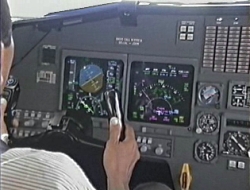An airspeed indicator assumes a cumulative error that’s
inversely proportional to speed. In other words, error increases as speed
decreases. Finally, when an airplane is flying very close to stall, an ASI may
be practically useless, a quivering needle bobbing near the bottom of the
gauge, reading anywhere from five to 30 knots slow. Conversely, angle of attack
indicators provide a continuous readout of margin above stall right down to the
actual event.
Um indicador da velocidade aerodinamica assume um erro cumulativo que é
inversamente proporcional à velocidade. Em outras palavras, o erro aumenta
quando diminui de velocidade. Finalmente, quando um avião está voando muito
perto do stall, umindicador de velocidade aerodinâmica pode ser praticamente inútil, um ponteiro
trêmulo oscilando na parte inferior do mostrador, apontando em qualquer lugar
de 5 a 30 nós. Por outro lado, indicadores de ângulo de ataque fornecem uma
leitura contínua da margem acima do stall até o evento real.
FAA Clears Path for Installation of Angle of Attack Indicators in Small Aircraft
For
Immediate Release
February 5, 2014
Contact: Les Dorr or Elizabeth Isham Cory
Phone: (202) 267-3883 (Les)/(847) 294-7849 (Elizabeth)
Contact: Les Dorr or Elizabeth Isham Cory
Phone: (202) 267-3883 (Les)/(847) 294-7849 (Elizabeth)
Measure Could Improve
Safety in Thousands of Aircraft
WASHINGTON – The Federal Aviation Administration (FAA) today took an
important step to help improve safety in small aircraft by simplifying design
approval requirements for a cockpit instrument called an angle of attack (AOA)
indicator. AOA devices, common on military and large civil aircraft, can
be added to small planes to supplement airspeed indicators and stall warning
systems, alerting pilots of a low airspeed condition before a dangerous
aerodynamic stall occurs, especially during takeoff and landing.
“Safety is our top priority, and
with today’s announcement we are improving safety by streamlining regulations
and cutting red tape – a win-win situation,” said U.S. Department of
Transportation Secretary Anthony Foxx.
An “angle of attack” is the angle
between a plane’s wing and the oncoming air. If the angle of attack becomes too
great, the wing can stall and lose lift. If a pilot fails to recognize and
correct the situation, a stall could lead to loss of control of the aircraft
and an abrupt loss of altitude. Stalls can happen during any phase of flight,
but they are critical when planes are near the ground and have less room to
recover, such as during landing and takeoff.
AOA indicators may help prevent loss
of control in small aircraft because they provide a more reliable indication of
airflow over the wing. Although they have been available for some time, the
effort and cost associated with gaining installation approval has limited their
use in general aviation. The streamlined requirements are expected to lead to
greater use of the devices and increased safety in general aviation.
“We have eliminated major barriers
so pilots can add another valuable cockpit aid for safety,” said FAA
Administrator Michael Huerta. “These indicators provide precise information to
the pilot, and could help many avoid needless accidents.”
Under the new policy, manufacturers
must build the AOA indicator system according to standards from the American
Society for Testing and Materials (ATSM) and apply for FAA approval for the
design via a letter certifying that the equipment meets ATSM standards and was
produced under required quality systems. The FAA’s Chicago Aircraft
Certification Office will process all applications to ensure consistent
interpretation of the policy.







Nenhum comentário:
Postar um comentário